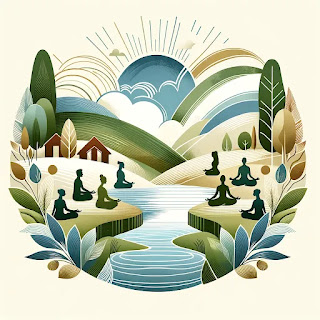Meditation for Health and Wellness: Techniques, Traditions, and Transformations
Meditation, practiced for thousands of years, combines art and science. It is both a personal journey of self-discovery and a subject of growing research, showing profound benefits for the mind, body, and overall health.
Rooted in traditions such as Buddhist mindfulness, Hindu mantra practices, and Christian contemplation, meditation has evolved into a universal tool for health and wellness, accessible to people of all backgrounds.

The art of meditation lies in the personal experience, each session is an opportunity to connect with the mind and find calm. The science reveals its measurable effects, including stress reduction, improved brain function, and better overall well-being.
In this article, we explore meditation techniques and traditions, highlighting both practical applications and scientific insights to show how meditation can transform individual lives and support a more mindful, connected society.
The Art of Meditation
At its heart, meditation is an art form, a personal journey of discovery and expression unique to each person. It transcends the simple act of sitting in silence; it’s an exploration of the mind and consciousness, a dance between the self and the universe.
Personal Experience and Creative Expression in Meditation:
Meditation invites us to engage with our inner selves, offering a canvas on which to paint our experiences of mindfulness, self-reflection, and tranquility. It is an intimate process where emotions, thoughts, and sensations are observed, accepted, and transformed. Each session is a unique expression of the moment, reflecting the meditator’s current state, environment, and mindset. This personal aspect of meditation underscores its artistry, where the practice becomes a form of self-expression and exploration.
Diversity of Techniques:
The beauty of meditation lies in its variety. From the focused attention on breath in mindfulness meditation to the repetition of sacred sounds in mantra meditation, each technique offers a different path to awareness and peace. Body-centered meditations, such as yoga and tai chi, combine movement with mindful awareness, emphasizing the connection between physical and mental well-being. This diversity allows individuals to find a practice that resonates with their personal preferences, needs, and lifestyle, making meditation accessible and adaptable.
The Role of Tradition in Shaping Meditation Practices:
Tradition serves as the foundation upon which the art of meditation is built. The ancient practices of Buddhist, Hindu, and Taoist meditations, among others, provide a wealth of knowledge, techniques, and philosophical underpinnings that inform modern practices. These traditions offer a connection to the past, a sense of continuity and community that enriches the personal experience of meditation. They teach us that meditation is not just a technique but a way of life, a practice imbued with meaning, purpose, and a deeper connection to the world around us.
In embracing the art of meditation, we embark on a journey that is both deeply personal and universally connected. The practice offers a space for creative exploration, where the mind becomes a canvas for the vivid colors of our inner world. Through the diversity of techniques and the wisdom of tradition, meditation provides a path to self-discovery, inner peace, and the boundless potential of the human spirit.
The Science of Meditation: Unveiling Its Transformative Power
In the exploration of meditation, science plays a pivotal role, transforming ancient practices into evidence-based strategies for modern well-being. Recent decades have witnessed an unprecedented surge in research, with studies offering compelling data on meditation’s capacity to reshape our minds, heal our bodies, and enhance our quality of life. This section delves into the concrete scientific findings that underscore the transformative power of meditation, presenting a vivid tableau of its benefits through the lens of data and research.
Empirical Evidence and Breakthrough Findings:
A landmark study, “Psychiatry Research: Neuroimaging” revealed that participants engaged in an eight-week mindfulness-based stress reduction (MBSR) program exhibited an increase in gray matter density in the hippocampus. Known for its role in learning and memory, and in structures associated with self-awareness, compassion, and introspection. At the same time, decreases were observed in the amygdala, which is involved in anxiety and stress responses, showcasing meditation’s direct impact on the brain’s architecture and emotional processing.
Quantifying Changes: Neurological and Physiological Shifts:
Research leveraging functional magnetic resonance imaging (fMRI) has shown that long-term meditators exhibit enhanced brain plasticity, with notable increases in cortical thickness and activity in regions associated with attention and sensory processing. Further, a systematic review highlighted in “JAMA Internal Medicine” concluded that meditation practices could lead to significantly lower blood pressure levels, akin to the effects of medication, but without the side effects. These findings not only underscore meditation’s role in stress management but also its potential as a non-pharmacological approach to cardiovascular health.
Mental Health and Cognitive Enhancements: A Data-Driven View:
The benefits of meditation extend deeply into mental health, with meta-analyses demonstrating its efficacy in reducing symptoms of anxiety and depression. For instance, a study from found that mindfulness meditation helped reduce anxiety levels by up to 30% in participants. On the cognitive front, research published suggested that meditation could slow the progression of cognitive decline, offering a beacon of hope for aging populations seeking to preserve mental acuity.
By weaving together the threads of empirical evidence, the scientific exploration of meditation illuminates its profound capacity to foster resilience, enhance cognitive function, and promote overall well-being. This marriage of data and practice not only validates the transformative power of meditation but also empowers individuals to harness its benefits, guided by the light of science.

Techniques and Traditions: A Journey Through Meditation’s Rich Landscape
Meditation is a mosaic of practices, each piece colored by centuries of tradition, culture, and individual insight. This diversity reflects humanity’s universal quest for peace, understanding, and connection. In this section, we explore the myriad techniques of meditation, unveiling the rich traditions that have nurtured and propagated them across the globe.
Exploring Various Meditation Techniques:
- Mindfulness Meditation: Rooted in Buddhist tradition, mindfulness meditation teaches us to be present in the moment, observing thoughts, feelings, and sensations without judgment. It’s the practice of being fully engaged with the now, fostering a deep sense of awareness and acceptance.
- Transcendental Meditation (TM): TM offers a unique approach by utilizing a mantra or a series of Sanskrit words to help the mind settle into a state of profound rest and relaxation. Originating from the Vedic tradition of India, it’s praised for its simplicity and effectiveness in reducing stress and enhancing creativity.
- Zen Meditation (Zazen): Stemming from Buddhist philosophy, Zazen is the art of sitting in quiet contemplation, focusing on posture and breath. It’s a discipline of insight, aiming to uncover the nature of existence and awaken one’s true self.
- Loving-Kindness Meditation (Metta): This practice involves directing feelings of love and kindness towards oneself and others. It’s rooted in the Theravada Buddhist tradition and is known for its capacity to cultivate compassion, empathy, and emotional resilience.
- Body Scan Meditation: A fundamental component of Mindfulness-Based Stress Reduction (MBSR) programs, this technique involves mentally scanning one’s body to identify and release tension. It teaches mindfulness of the body and is often used as a gateway to deeper meditative practices.
The Influence of Cultural Traditions:
The beauty of meditation lies not just in its practices but in the stories, philosophies, and traditions that accompany them. From the monastic temples of Japan to the sacred texts of India, cultural traditions have played a pivotal role in preserving and interpreting meditation’s wisdom. They provide context, meaning, and depth to the practice, linking individual experience to a larger narrative of human seeking and spiritual inquiry.
In the West, the adaptation of meditation practices has led to a flourishing of new perspectives, integrating scientific understanding with ancient wisdom. This cross-cultural exchange has enriched the meditation landscape, offering a broader array of practices that cater to diverse needs and preferences.
A Path of Personal and Collective Discovery:
The journey through meditation’s techniques and traditions is both a personal voyage and a collective exploration. It invites us to discover not only the depth of our own consciousness but also the shared human capacity for reflection, compassion, and transformation. As we delve into these practices, we weave our own stories into the rich tapestry of meditation’s global heritage, contributing to its ongoing evolution and relevance in the modern world.
Transformations Through Meditation: Personal and Societal Renewal
The practice of meditation is more than a momentary retreat from the chaos of daily life; it’s a transformative journey that reshapes our inner landscape and influences the world around us. Through personal anecdotes and scientific research, we’ve seen time and again how meditation facilitates profound personal growth and societal change. This section delves into these transformations, highlighting the profound impact meditation can have on our lives and communities.
Personal Transformation: A Journey to the Self
Meditation offers a pathway to deep self-discovery and personal growth. Practitioners often report significant shifts in their perspective on life, experiencing increased self-awareness, emotional resilience, and a sense of inner peace. These changes are not superficial; they are deeply rooted transformations that enhance one’s relationship with oneself and the world.
- Increased Self-Awareness: Regular meditation cultivates an enhanced awareness of one’s thoughts, emotions, and behaviors, fostering a greater understanding of oneself and facilitating mindful living.
- Emotional Resilience: By teaching us to observe our emotions without judgment, meditation strengthens our ability to navigate life’s ups and downs with grace and equanimity.
- Inner Peace: The practice of meditation quiets the mind and soothes the soul, leading to a profound sense of peace that radiates from within, influencing all aspects of life.
Societal Impact: Cultivating a Culture of Peace and Understanding
The benefits of meditation extend far beyond the individual, contributing to a more compassionate, empathetic, and understanding society. By fostering a sense of connectedness and shared humanity, meditation practices have the potential to bridge cultural, social, and political divides.
- Community and Connection: Meditation groups and retreats build strong communities of practice, fostering connections that transcend individual differences and promote mutual respect and understanding.
- Empathy and Compassion: Practices like loving-kindness meditation (Metta) explicitly cultivate feelings of goodwill and compassion towards others, contributing to a more empathetic society.
- Global Awareness: The mindfulness cultivated through meditation encourages a deeper awareness of our impact on the world, inspiring actions that are in harmony with the well-being of our planet and its inhabitants.
The Future of Meditation: A Vision for Transformation
As meditation continues to gain popularity, its potential to effect change on a global scale becomes increasingly evident. The practice offers a blueprint for personal well-being and societal harmony, embodying a vision for a world where mindfulness, compassion, and understanding prevail. By embracing the transformative power of meditation, we open ourselves to the possibility of a renewed human experience, marked by deeper connections, shared compassion, and collective well-being.

Conclusion: Embracing the Art and Science of Meditation for a Transformed World
As we conclude our exploration of “The Art and Science of Meditation: Techniques, Traditions, and Transformations,” we stand at the intersection of ancient wisdom and modern science, witnessing the remarkable journey meditation has made from secluded monasteries and ancient scriptures to scientific journals and digital apps. This journey reveals meditation not just as a practice but as a profound movement towards understanding the depths of the human mind and spirit.
A Fusion of Art and Science
Meditation embodies the beautiful convergence of art and science. Through the art of meditation, we engage in a deeply personal exploration of our inner worlds, using the mind as a canvas for the broad strokes of our thoughts and emotions. Simultaneously, the science of meditation offers a lens through which we can view the tangible, transformative effects of this practice on our brains, bodies, and behaviors, grounded in empirical evidence and research.
A Tapestry of Techniques and Traditions
The variety of meditation techniques and traditions underscores the universality and adaptability of the practice. Whether it’s the silent repetition of a mantra, the mindful attention to breath, or the cultivation of loving-kindness, each technique invites us into a deeper relationship with ourselves and the world. The rich traditions from which these practices emerge provide a cultural and historical context that enriches our understanding and appreciation of meditation.
A Vision for Personal and Societal Transformation
The transformative power of meditation extends far beyond individual well-being, offering a blueprint for societal change. By fostering greater self-awareness, emotional resilience, and compassion, meditation practices have the potential to reshape our communities, bridge divides, and cultivate a more peaceful, understanding world.
As we embrace the art and science of meditation, we open ourselves to a journey of discovery, healing, and transformation. This journey not only promises personal growth and well-being but also points towards a future where mindfulness, compassion, and connectedness are at the heart of our collective experience.
In the spirit of “The Art and Science of Meditation,” let us continue to explore, practice, and share the profound benefits of this timeless tradition. Together, we can transform our lives and the world around us, one mindful moment at a time.





